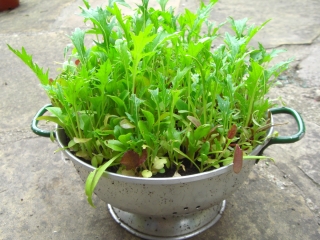Lessons from our summer of growing
So the summer growing season is just about over here. We’ve still got some chillis growing and ripening, and there is some winter-time veg still on the go, but the summer is just about done.
As our first summer in our new house, I always said it was going to be a year of experimentation and by mid-season, I’d already learned a lot and made a number of resolutions for next year. The last half of the season has added to that list.
Overall, it’s been a bit disappointing – I’ve learned from my mistakes and the quirks of this garden – but let’s start with some positives:
- Borage has been a big success. I grew it almost entirely as a bee attractor and it did its job well. It grew bigger and better than I thought it would, and while we didn’t like it, the chickens LOVE it. I won’t grow it in the same place next year, but I’ll definitely grow it again.
- We’ve had a lot more courgettes (& marrow) than I thought we’d get – I gave away some of the plants and they gave one or two fruits then died, but here, they gave and gave. Wonderful.
- We also had a lot of salad leaves at the start of the summer (later they became bitter, not sure why). We ate salad with both lunch and dinner almost every day for about six weeks – low effort, high impact, ace. I’ll grow more next year, from earlier to later.
I’ve learned a considerable amount about specific vegetables but some more general things:
- In order for things to reach maturity in good time here, I need to sow them (and planted them on etc) at the start of the advised growing window. We get a decent amount of sun but it’s Yorkshire sun so they need as many days as possible to get up to size.
- Similarly, I need to use the biggest possible pot at every stage. A lot of seedlings got either weak & leggy or stalled while waiting to be potted on. I’m tempted to start most things in pots rather than plugs next year – the space saving isn’t worth it in the long run, especially as we’ll have more nursery space now the greenhouse is in place.
- Slugs and snails don’t just eat the third I’ve mentally set aside for them, really devastated the peas & beans earlier in the year, then the brassicas we planted out on mass a few weeks ago. The gits. Next year I’ll use nematodes just before the spring seedlings are planted out and again, before the autumn-planted ones go in. I’ll also keep more cheap & nasty beer on hand to keep the slug traps filled up.
- After the slugs had done their business with more than half the plants, we struggled to have enough beans or peas ready at any one time, to warrant harvesting and eating them. We found it a lot easier to enjoy veg that could be enjoyed when just one or two were ready – courgettes, tomatoes, chillis, a plant’s worth of potatoes…
- Only grow a manageable amount of each type of seed. I accidentally grew about 40 butternut squash seedlings (I’d planned for 5 to 8) and it overwhelmed my nursery space, our limited bed space and my equally limited time. They stalled and failed. I grew too many of a number of things too – I think the big plug trays and slug fear drew me into doing it. It would be better to grow a smaller amount of plants that I could manage more efficiently.
I think next year I’d also like to have some way of measuring our output – so I can keep a track of it year on year. I’m not sure weight is the way to do it for us because stuff like lettuce weighs next to nothing but is very valuable as an addition to a meal – usually expensive to buy in the shops and with a high food mile footprint. Ditto herbs and chillis. Perhaps I’ll keep a track of output related to meals – whether it was the main ingredient, a side dish or a garnish etc.
Anyone got any good ways of tracking that sort of thing?
What lessons have you learned from your garden this year?
7 Comments
Join the conversation and post a comment.
Trackbacks/Pingbacks
- Why our growing season was disappointing | The Really Good Life - [...] know how the other week, I said it had been a disappointing growing year? Well, this is a case…






I agree with all of that.
I found that everything I transplanted or potted on did nothing for a couple of weeks afterwards – shock? I’m aiming to plant things straight into their final growing place wherever possible.
I tried doing that with some stuff this year and it all got eaten – every time a new leaf appeared, it was eaten within the day. The only exceptions to that were garlic & the salad I grew on our metal balcony. Perhaps I’ll try again elsewhere after nematode-ing next year.
I don’t really recommend this, as it’s neither frugal nor green, but I had good early success with beetroot last year after covering each individual plant with a cut-in-half clear plastic bottle. Inside each bottle I put a few slug pellets.
It’s very labour intensive, as you end up having to visit each plant every couple of days to check on it, remove the bottle, water it, replace.
I live in the Pacific Northwest, where slug problems are terrible. I’m conducting science experiments to figure out what works best for slug control. Unfortunately many of the remedies you read about simply don’t work. You can read my experiments and see photos here: http://amysoddities.blogspot.com/2010/09/slugs.html
Great work, Amy! I’ve seen (or at least perceived) a decrease in damage after using copper pipes and coffee grounds and I think if the method is free/green, it can’t help to try but your experiments show I shouldn’t be too hopeful. Thanks for the comment & link!
If you do start your seeds in little pots, then transplant when they’re bigger-try potting them in something biodegradable. Eggshells, cardboard, ect. No possibly damaging tender roots by pulling them out of their little pots. That’s also the rationale behind pinching back seedlings that have sprouted too thickly, as opposed to yanking them up by the roots. Try wrapping aluminum foil around the stems of new plants in the garden, to help keep slugs at bay. I’ve heard a loop of copper wire laid on the ground is supposed to be effective-I have no idea if that’s so. And, since they don’t like crawling over sharp things-would a layer of crushed eggshell be sharp enough?
I hate slugs-bleagh. I once impulsively laid on the grass to look up at the stars one beautiful night. Got up, came inside-to find my back was covered with slugs! Eek!
Oh, and willow water is supposed to be marvelous for transplant shock, as well as rooting cuttings. You put willow leaves and stems in a jar of water to soak for a few days, and water your transplants with it. Worth a try?
I was walking past a willow tree the other day and half-remembered that they were really useful for something – and that’s it! It’s used to encourage roots/as a natural rooting hormone.
Thanks for jogging my memory, bookstorebabe :)